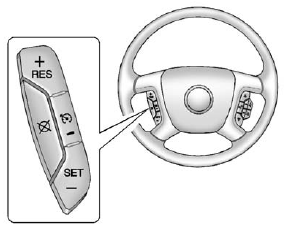Cruise Control
With cruise control, a speed of about 40 km/h (25 mph) or more can be maintained without keeping your foot on the accelerator. Cruise control does not work at speeds below about 40 km/h (25 mph).
When the brakes are applied, the cruise control is disengaged.
WARNING
Cruise control can be dangerous where you cannot drive safely at a steady speed. So, do not use the cruise control on winding roads or in heavy traffic.
Cruise control can be dangerous on slippery roads. On such roads, fast changes in tire traction can cause excessive wheel slip, and you could lose control. Do not use cruise control on slippery roads.

The cruise control buttons are located on left side of the steering wheel.
 (On/Off): Press to turn cruise control on and off. The indicator comes on when cruise control is on.
(On/Off): Press to turn cruise control on and off. The indicator comes on when cruise control is on.
+ RES (Resume/Accelerate):
Press briefly to make the vehicle resume to a previously set speed, or press and hold to accelerate.
SET–: Press to set the speed and activate cruise control or to make the vehicle decelerate.
 (Cancel): Press to disengage cruise control without erasing the set speed from memory.
(Cancel): Press to disengage cruise control without erasing the set speed from memory.
See also:
Initial Drive Information
This section provides a brief overview about some of the important features that may or may not be on your specific vehicle.
For more detailed information, refer to each of the features which can be ...
Driving in Water
WARNING
Driving through rushing water can be dangerous. Deep water can sweep your vehicle
downstream and you and your passengers could drown. If it is only shallow water,
it can still wash away t ...
Reprogramming Universal Home Remote Buttons
Any of the three buttons can be reprogrammed by repeating the instructions. ...





